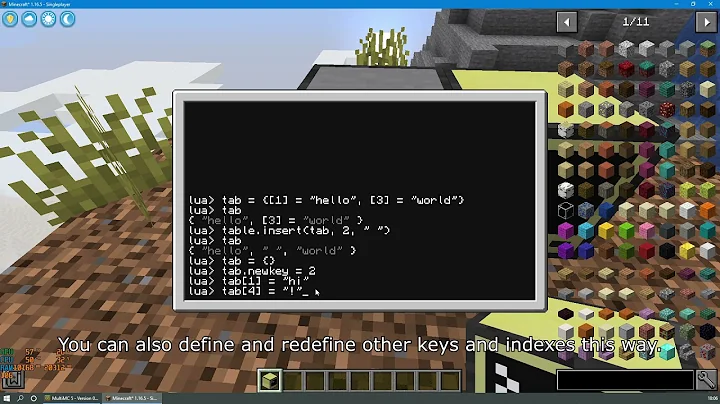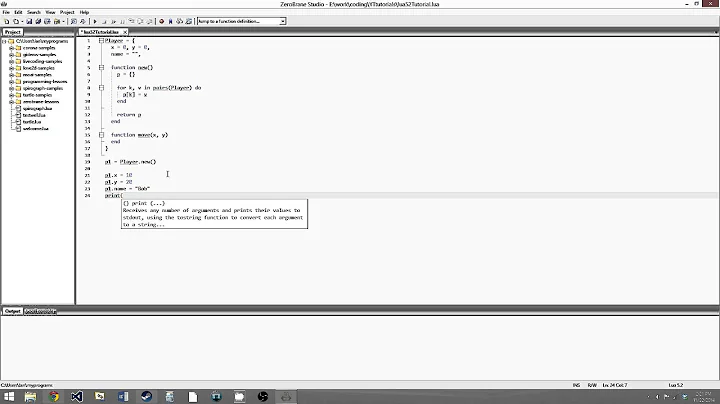how to delete all elements in a Lua table?
Solution 1
for k in pairs (t) do
t [k] = nil
end
Will also work - you may have difficulty with ipairs if the table isn't used as an array throughout.
Solution 2
Table elements insert and remove performance compare
The Table size count 10000000
[1] while and rawset
while #t ~= 0 do rawset(t, #t, nil) end
spent time = 0.677220
[2] next and rawset
for k in next, t do rawset(t, k, nil) end
spent time = 0.344533
[3] ipairs and rawset
for i, v in ipairs(t) do t[i] = nil end
spent time = 0.012450
[4] for, rawset
count = #t
for i=0, count do t[i]=nil end
spent time = 0.009308
Table elemnets insert
[1] table insert function
for i=0, 10000000 do table.insert(t, i, i) end
spent time = 1.0590489
[2] use #t
for i=0, 10000000 do t[#t+1] = i end
spent time = 0.703731
[3] for, rawset
for i=0, 10000000 do rawset(t, i, i) end
spent time = 0.100010
result.
Fastest remove : 4
Fastest insert : 3
Solution 3
easiest and most performant:
for k,v in pairs(tab) do tab[k]=nil end
What you suggest isn't usable: table.remove shifts the remaining elements to close the hole, and thus messes up the table traversal. See the description for the next function for more info
Solution 4
For a faster version that ignores the __pairs metamethod:
local next = next
local k = next(tab)
while k ~= nil do
tab[k] = nil
k = next(tab, k)
end
EDIT: As @siffiejoe mentions in the comments, this can be simplified back into a for loop by replacing the pairs call with its default return value for tables: the next method and the table itself. Additionally, to avoid all metamethods, use the rawset method for table index assignment:
for k in next, tab do rawset(tab, k, nil) end
Solution 5
#table is the table size and so if t = {1,2,3} then #t = 3
So you can use this code to remove the elements
while #t ~= 0 do rawset(t, #t, nil) end
You will go through the table and remove each element and you get an empty table in the end.
Related videos on Youtube
bob
Updated on July 09, 2022Comments
-
bob almost 2 years
How do I delete all elements inside a Lua table? I don't want to do:
t = {} table.insert(t, 1) t = {} -- this assigns a new pointer to tI want to retain the same pointer to t, but delete all elements within
t.I tried:
t = {} table.insert(t, 1) for i,v in ipairs(t) do table.remove(t, i) endIs the above valid? Or is something else needed?
-
AndersH about 13 yearsI guess the situation is to empty a table in a function taking it as a parameter. Then the question is a good one, +1. I was at first confused about the word "pointer", which exists in c-code and shouldn't be mentioned in Lua-code. You mean "reference" or something.
-
-
siffiejoe over 9 yearsOr just
for k in next,tab do tab[k] = nil end -
 Klaatu von Schlacker over 5 yearsThis is a thorough and effective answer.
Klaatu von Schlacker over 5 yearsThis is a thorough and effective answer. -
Danger Code master over 5 yearsAccording to lua.org/gems/sample.pdf (a Lua optimization guide), this method is surprisingly terrible. The problem is that setting an element to nil typically does not delete it from the table until the next resize. The implementation of next has to search through all the nils before it returns, making this a surprise O(n^2).
-
bonsaiviking over 5 years@AHelps Thanks for pointing that out! My longer
whileversion doesn't suffer from this becausenextis called with a previous index. @siffiejoe's version is missing that part, so it does the slow version. I'll make an explanatory edit to the answer. -
bonsaiviking over 5 years@AHelps actually, I take that back: the "generic
forloop" construct automatically takes the return value of the iterator function as the second parameter to the function in the next iteration. So first iteration isk = next(tab, nil), but the next iteration isk = next(tab, k), which avoids the full traversal.





![[LUA] Ep. 5 - Tables](https://i.ytimg.com/vi/7Oxh7MJAd5k/hq720.jpg?sqp=-oaymwEcCNAFEJQDSFXyq4qpAw4IARUAAIhCGAFwAcABBg==&rs=AOn4CLDmJzuz8WBLb5n2jMfnSQM6mNQzNQ)



